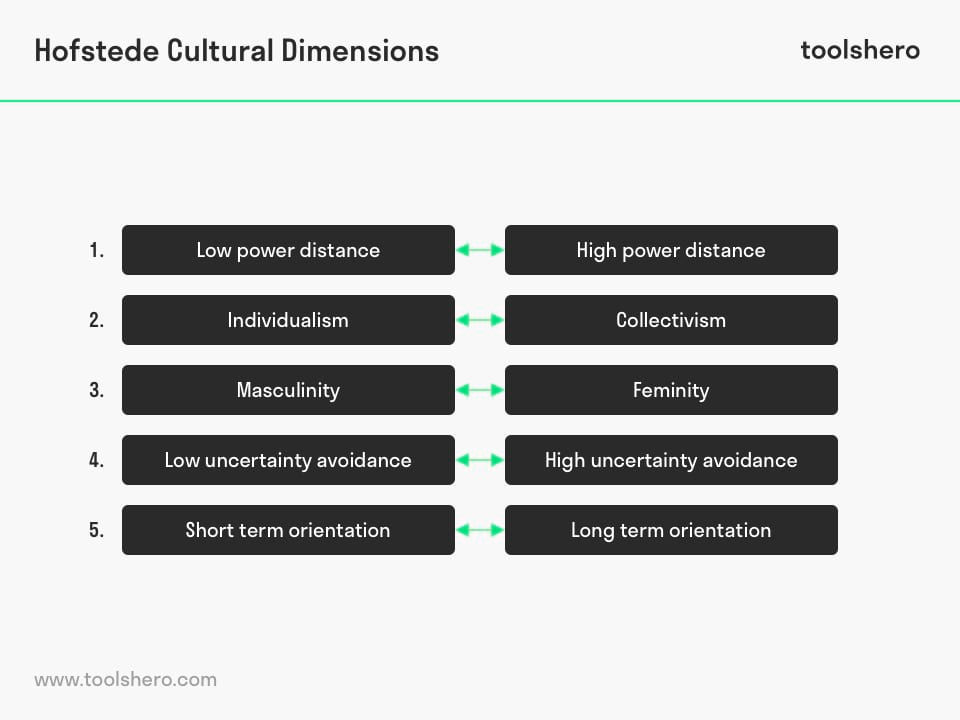Hofstede Cultural Dimensions Theory

Hofstede Cultural Dimensions: this article explains the Hofstede Cultural Dimensions, developed by Geert Hofstede in a practical way. Next to what Globalization is, this article also highlights what the 6 Hofstede Cultural Dimensions are. After reading you will understand the basics of this organization cultural analysis tool. Enjoy reading!
What is Globalization? Concept explained
Globalization is still a familiar concept today. All kinds of technological developments enable people to communicate with each other throughout the world and this also applies to organizations.
Globalization, communication and organizations are therefore accompanied by different cultures. People who work in international business may be taken by surprise when they learn how people behave in different cultures.
According to Geert Hofstede culture is more often a source of conflict than of synergy.
What are the Hofstede Cultural Dimensions?
In order to bridge the differences, Geert Hofstede started a large survey study within the IBM organization in 56 countries in 1970.
His survey study has provided us with an insight into other countries and cultures, especially with respect to effective interactions between people.
After more than 1.000 interviews and a variety of angles, the Hofstede model of Cultural Dimensions emerged. Initially, four dimensions were identified. Later, the fifth and sixth dimension were added to the Hofstede Cultural Dimensions.
In successive studies these dimensions of culture were identified for over 50 countries. Each country has a scale from 1 to 100 for each dimension. The higher the score, the more the dimension in question emerges in the culture. The Hofstede Cultural Dimensions are set out in a structural model using a versus construction.

Figure 1 – the 6 Hofstede Cultural Dimensions
1. Low power distance versus high power distance
The definition of power distance (Power Distance Index (PDI)) within the Hofstede Cultural Dimensions refers to the measure of inequality that exists- and is accepted – by people with and without power. This represents the inequality in the distribution of power (high versus low), but in the sense of acceptance.
A high PDI score indicates that a high power distance can be observed in which the conclusion can be drawn that there is great inequality in society (culture). Strong hierarchical relationships, displays of little respect and authority can be traced back to most Asian countries.
A low score represents a low power distance. Here equality can be perceived and this can mainly be traced back to European countries.
2. Individualism versus collectivism
The definition of Individualism (IDV) within the Hofstede Cultural Dimensions refers to the strength of the mutual ties between individuals within a certain community.
A high score represents ‘loose‘ (lack of interpersonal) connections and little sharing of responsibility. The individuals in these individualistic societies value people’s time and their need for freedom highly. Respect for privacy and expectations of rewards for hard work are also characteristics of a high score.
A society with a low score (a collectivist society) would have a strong group cohesion, a large amount of loyalty and respect for members within a certain community. The emphasis is on developing skills and becoming a kind of ‘guru’, master or expert of something. Working for intrinsic rewards is also an important characteristic. Harmony is more important than honesty.
3. Masculinity versus femininity
This definition (Masculinity – MAS) within the Hofstede Cultural Dimensions refers to how much a society complies with its values and traditional male and female roles. For men the emphasis is on performance and success whereas for women the emphasis is on modesty, sensitivity and the quality of life.
In countries with high scores on masculinity, people are generally masculine (tough, strong and assertive) and vice versa: in feminine societies, people are generally feminine (submissive, subservient and kind). In Low MAS scoring countries, the distinction between the gender roles of men and women is not transparent. Women also work in male-dominated professions, there is much cooperation and men are allowed to be sensitive and kind. In addition, powerful and successful women are admired and respected.
4. Low uncertainty avoidance versus high uncertainty avoidance, the 4th dimension of the Hofstede Cultural Dimensions
The definition of ‘uncertainty‘ (Uncertainty/Avoidance Index – UAI) within the Hofstede Cultural Dimensions refers to the degree of anxiety that society members feel when they are faced with uncertainty and ambiguity in their life.
High scoring nations avoid uncertain situations through control (rules and order). They seek a collective truth to which they link expectations with a certain degree of security. Low scoring nations enjoy, for example, new events and initiatives. People have an informal attitude, and they accept change and risk.
5. Short term orientation versus long term orientation
This dimension refers to society rules based on traditions and centuries-old traditions. This dimensions was partially developed by researcher Michael Minkov.
These apply to both the short and the long term. The following characteristics can be perceived in high scoring nations: family is the basis of society, education and training are highly valued and elderly people and men have more authority than young people and women.
This is especially perceived in Asian countries. Low scoring countries promote high creativity and individualism. People treat each other as equals and they are willing to help each other execute the most innovative plans and ideas.
6. Indulgence vs restraint, the 6th dimension of the Hofstede Cultural Dimensions
This sixth dimension is about the degree of freedom that is important for members of a society in fulfilling their human desires. Indulgence is defined as a society in which man is left free to enjoy life and have fun. Its counterpart, restraint, is about a society in which the satisfaction of these needs is strictly controlled by social norms.
How to use the Hofstede Cultural Dimensions in business?
The Hofstede Cultural Dimensions can be used in business to gain a better understanding of the cultural differences that exist between countries and how these differences can affect business practices. Here are some ways to use Hofstede’s Cultural Dimensions in business:
Cross-Cultural Communication
Understanding cultural dimensions can help business leaders communicate effectively with people from different cultures. By recognizing how different cultures approach communication, you can adjust your style and language to build rapport and avoid misunderstandings.
Human Resources Management
The cultural dimensions can provide insight into how to manage employees from different cultures. For example, individualistic cultures may value recognition and rewards for individual achievements, while collectivistic cultures may value teamwork and group harmony.
Marketing and Advertising
Cultural dimensions can help businesses tailor their marketing and advertising messages to different cultures. Masculine cultures may respond well to ads that emphasize achievement and competition, while feminine cultures may respond better to ads that emphasize relationships and social responsibility.
International Expansion
Before expanding into new countries, businesses should conduct a thorough analysis of the cultural dimensions of the target market. This analysis can help businesses understand the cultural differences that may affect their operations, marketing, and overall success in the new market.
Overall, using Hofstede’s Cultural Dimensions in business can help companies build better relationships with clients, customers, and employees from different cultures, avoid cultural misunderstandings, and create successful global businesses.
Summary Hofstede Cultural Dimensions
Hofstede’s Cultural Dimensions is a theory that describes how national culture influences behavior and values in different societies. The theory identifies six dimensions of culture, including power distance, individualism-collectivism, masculinity-femininity, uncertainty avoidance, long-term orientation, and indulgence-restraint.
Power distance refers to the degree to which a culture accepts and expects that power is distributed unequally, while individualism-collectivism relates to the balance between individual needs and group goals. Masculinity-femininity distinguishes the degree to which a culture is driven by competitiveness and achievement versus nurturing and cooperation. Uncertainty avoidance measures the degree to which a culture suppresses the gratification of needs and regulates behavior in the face of uncertainty.
Long-term orientation versus short-term orientation reflects the extent to which a culture focuses on immediate gratification versus long-term goals. Indulgence-restraint refers to enjoying life and having fun versus controlling one’s desires and impulses.
Hofstede’s theory enables country comparison and defines culture as a shared set of values, beliefs, and practices that guide behavior in a particular society. National culture is shaped by history, geography, religion, and other factors, and it affects individuals’ communication styles, decision-making, and work preferences. Understanding cultural dimensions is crucial for effective communication and cooperation across diverse cultures and societies.
It’s Your Turn
What do you think? Are the Hofstede Cultural Dimensions still applicable in today’s modern economy and global companies? Do you recognize the practical explanation or do you have more additions? What are your success factors for a good Hofstede Cultural Dimensions study?
Share your experience and knowledge in the comments box below.
More information
- Hofstede, G. (1984). Cultural dimensions in management and planning. Asia Pacific journal of management, 1(2), 81-99.
- Hofstede, G. & Bond, M. H. (1984). Hofstede’s Culture Dimensions An Independent Validation Using Rokeach’s Value Survey. Journal of cross-cultural psychology, 15(4), 417-433.
- Hofstede, G. & Hofstede, G. J. (2005). Cultures and Organizations: Software of the Mind. McGraw Hill.
How to cite this article:
Mulder, P. (2009). Hofstede Cultural Dimensions Theory. Retrieved [insert date] from Toolshero: https://www.toolshero.com/communication-methods/hofstede-cultural-dimensions/
Published on: 12/09/2013 | Last update: 12/09/2023
Add a link to this page on your website:
<a href=”https://www.toolshero.com/communication-methods/hofstede-cultural-dimensions/”>Toolshero: Hofstede Cultural Dimensions Theory</a>












